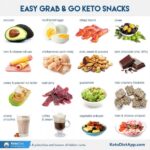Embark on a culinary adventure with ten delectable keto recipes, perfectly tailored for beginners. Imagine vibrant colors, tantalizing aromas, and the satisfying crunch of perfectly prepared keto-friendly meals. This guide isn’t just about recipes; it’s about unlocking a healthier lifestyle through simple, delicious, and surprisingly easy-to-make keto dishes. Discover the secrets to mastering the ketogenic diet, from perfectly balanced breakfasts to satisfying dinners, all while avoiding common pitfalls and embracing the joy of delicious, healthy eating.
We’ll demystify the ketogenic diet, explaining the essential macronutrient ratios and dispelling common misconceptions. Through step-by-step instructions, mouthwatering visuals, and helpful tips, you’ll learn to create a variety of keto meals that nourish your body and delight your taste buds. Whether you’re a seasoned cook or a kitchen novice, this guide provides the foundation for a successful keto journey, filled with flavorful and fulfilling meals.
Introduction to Ketogenic Diet for Beginners
Embarking on a ketogenic diet can feel like stepping into a new world of nutrition. It’s a high-fat, moderate-protein, and very-low-carbohydrate eating plan that shifts your body’s primary fuel source from glucose (derived from carbohydrates) to ketones (derived from fat). This metabolic shift, called ketosis, offers a unique approach to weight management and has potential benefits for certain health conditions. Understanding the basics is key to a successful and safe keto journey.
The ketogenic diet fundamentally alters how your body uses energy. Instead of relying on readily available glucose from carbohydrates, your liver converts fat into ketones, which your brain and other organs can use for fuel. This process requires a significant reduction in carbohydrate intake, typically to 20-50 grams per day, depending on individual needs and goals. Protein intake is moderate, supporting muscle mass and overall health, while fat makes up the majority of your daily calories. A common macronutrient ratio for keto is approximately 70-80% fat, 20-25% protein, and 5-10% carbohydrates. This precise ratio can be adjusted based on individual factors and response to the diet.
Macronutrient Ratios in a Ketogenic Diet
The cornerstone of the ketogenic diet lies in its specific macronutrient ratios. Maintaining these ratios is crucial for inducing and sustaining ketosis. A typical ketogenic diet aims for a macronutrient breakdown where fat provides the lion’s share of daily calories. Imagine a plate visually divided into three sections: the largest section overflowing with healthy fats like avocado, olive oil, nuts, and fatty fish; a moderately sized section filled with lean protein sources such as chicken breast, fish, and eggs; and a tiny section representing the limited carbohydrate intake, perhaps a small handful of berries or a few leafy greens. This visual representation emphasizes the substantial difference in portion sizes between the macronutrients. The exact percentages can vary based on individual factors, but the principle of high fat, moderate protein, and very low carbohydrates remains constant.
Common Misconceptions about the Keto Diet
Many misconceptions surround the ketogenic diet, often leading to hesitation or incorrect implementation. Understanding these misconceptions and their factual counterpoints is vital for a successful keto journey.
- Misconception: Keto is only for weight loss. Fact: While weight loss is a common benefit, the ketogenic diet is also explored for its potential in managing certain neurological conditions, such as epilepsy, and improving metabolic markers associated with type 2 diabetes. The metabolic effects extend beyond simple weight reduction.
- Misconception: Keto is unhealthy and leads to heart disease. Fact: A well-planned keto diet focusing on healthy fats, such as avocados, olive oil, and nuts, can actually improve cholesterol profiles in some individuals. However, relying heavily on processed foods high in saturated fats can be detrimental. The key is to prioritize healthy fat sources.
- Misconception: Keto is unsustainable and restrictive. Fact: While initial adjustments may be necessary, many people find the keto diet to be surprisingly sustainable once they find recipes and meal plans they enjoy. A wide variety of keto-friendly foods are available, and meal prepping can simplify the process. The perceived restriction can be overcome with creative cooking and planning.
Addressing Common Keto Challenges and Troubleshooting

Embarking on the ketogenic diet can be a rewarding journey, but it’s not always smooth sailing. Many beginners encounter hurdles that can feel discouraging. Understanding these common challenges and implementing practical solutions is key to a successful and sustainable keto lifestyle. This section will address three prevalent difficulties and offer straightforward strategies to navigate them.
Keto Flu
The “keto flu” is a common initial reaction to starting a ketogenic diet. It’s characterized by symptoms like headaches, fatigue, dizziness, nausea, and constipation, all stemming from the body’s transition to using fat as its primary fuel source. This transition involves shifts in electrolyte balance and fluid levels. The body is adjusting to a new metabolic state, and these symptoms are often temporary.
Effective strategies to mitigate keto flu include prioritizing hydration, replenishing electrolytes, and gradually transitioning to a ketogenic diet. Avoid drastic dietary changes and instead slowly decrease carbohydrate intake while increasing healthy fats and proteins. This gradual approach allows the body to adapt more smoothly.
Constipation
A reduction in fiber intake, a common occurrence when transitioning to a keto diet, can lead to constipation. The ketogenic diet typically emphasizes low-carbohydrate, high-fat foods, many of which are not high in fiber. This lack of fiber can slow down digestion and make bowel movements infrequent and difficult.
Combatting constipation on keto requires a focused approach on increasing fiber intake from keto-friendly sources. This can be achieved by incorporating foods like avocados, chia seeds, flax seeds, and leafy green vegetables. Adequate hydration also plays a vital role in maintaining regular bowel movements. Consider adding psyllium husk, a soluble fiber supplement, to your daily routine, but always consult with a healthcare professional before adding supplements to your diet.
Electrolyte Imbalances
The ketogenic diet can disrupt electrolyte levels, particularly sodium, potassium, and magnesium. These electrolytes are crucial for numerous bodily functions, including nerve and muscle function, hydration, and blood pressure regulation. Electrolyte imbalances can manifest as muscle cramps, fatigue, headaches, and dizziness, exacerbating the symptoms of keto flu.
Maintaining sufficient electrolyte levels is paramount for successful keto adaptation. Staying well-hydrated is essential, as water is the vehicle for electrolyte transport throughout the body. Prioritize consuming electrolyte-rich foods and beverages. Examples of electrolyte-rich foods include bone broth, leafy greens, avocados, and coconut water. Electrolyte supplements can also be considered, but always consult a healthcare professional before starting any supplementation.
From fluffy keto pancakes to savory salmon dinners, this collection of ten recipes provides a springboard to a healthier, more energized you. Remember, the ketogenic diet is a journey, not a race. Embrace the process, celebrate your successes, and don’t hesitate to experiment and adapt these recipes to your own preferences. With a little practice and a dash of creativity, you’ll be crafting delicious keto meals that are as satisfying as they are healthy, transforming your relationship with food and your overall well-being. Enjoy the delicious possibilities that await!
Answers to Common Questions
What are the best keto sweeteners to use?
Erythritol, stevia, and monk fruit are popular keto-friendly sweeteners with minimal impact on blood sugar.
How do I manage keto flu symptoms?
Stay hydrated, increase electrolyte intake (sodium, potassium, magnesium), and gradually increase fat consumption.
Can I eat any type of fat on keto?
Prioritize healthy fats like avocados, olive oil, nuts, and seeds. Limit saturated and trans fats.
What if I accidentally eat too many carbs?
Don’t panic! It’s okay to have occasional slip-ups. Just get back on track with your keto meal plan.
How often should I weigh myself on keto?
Weighing yourself once a week is sufficient; daily weigh-ins can be discouraging.


